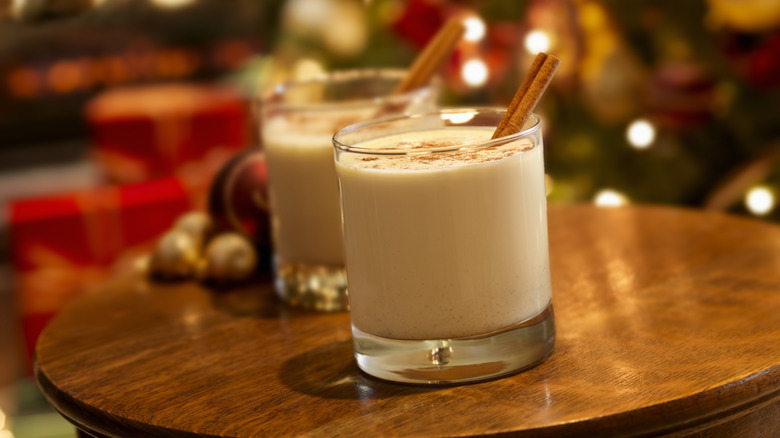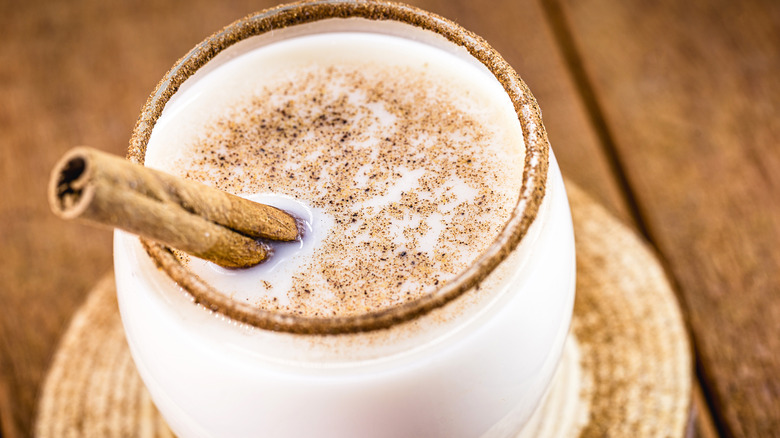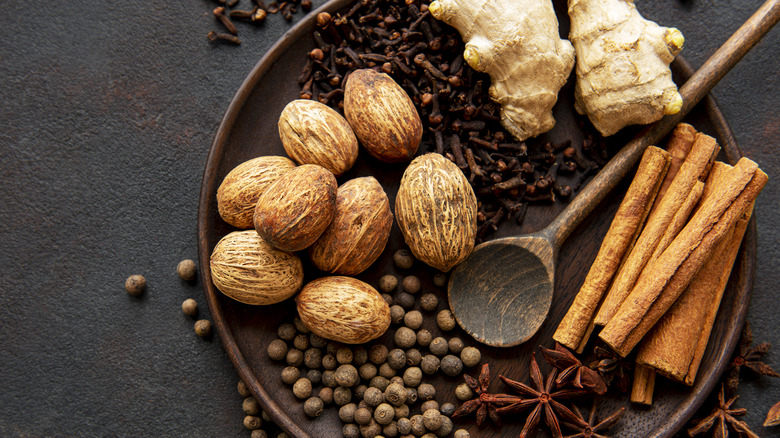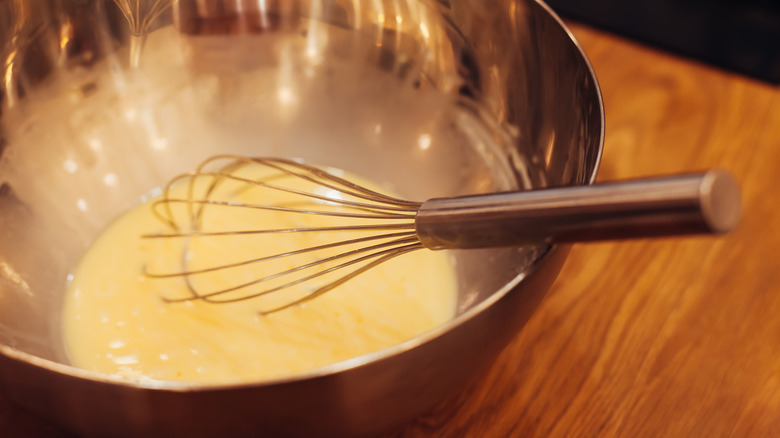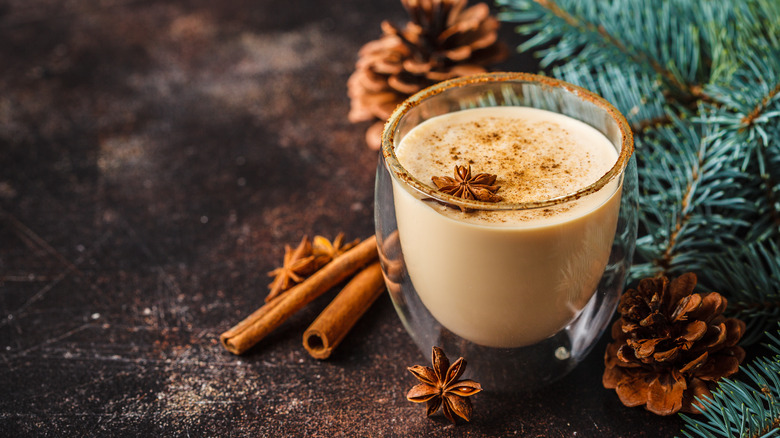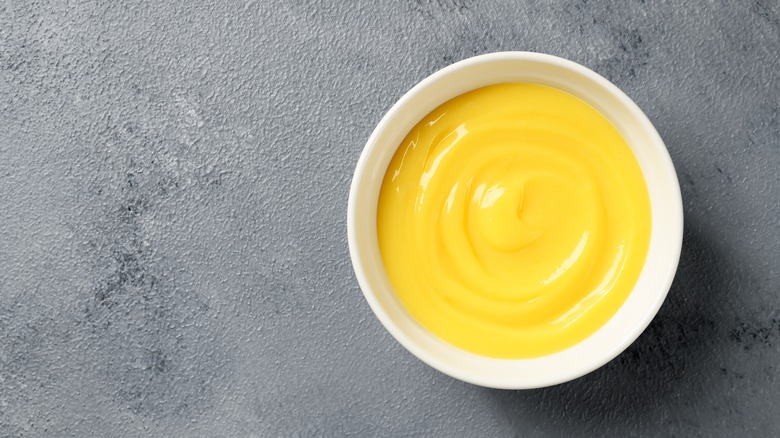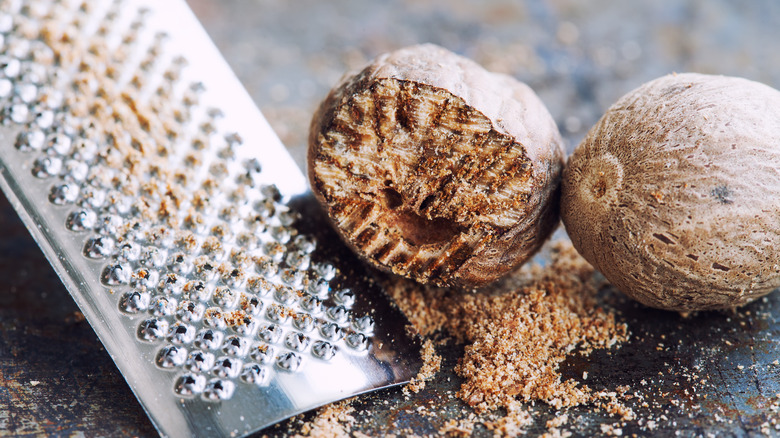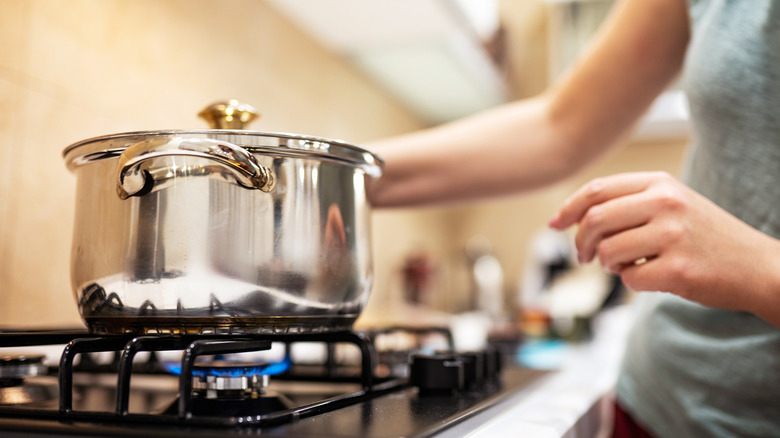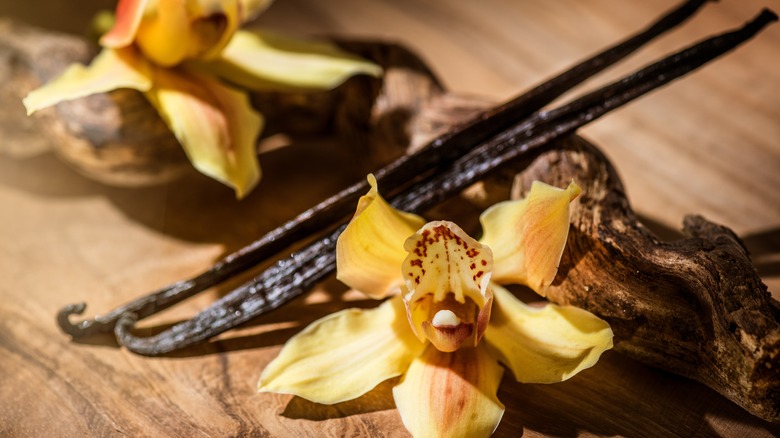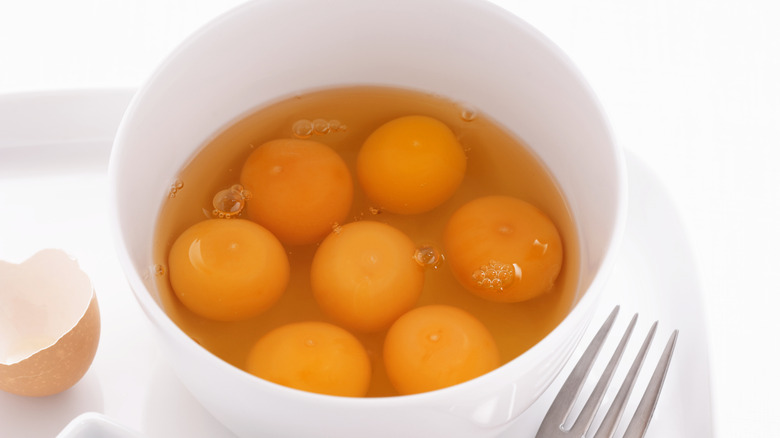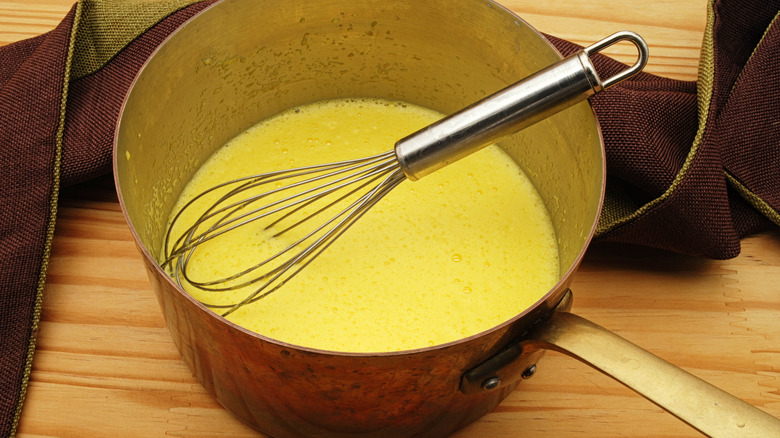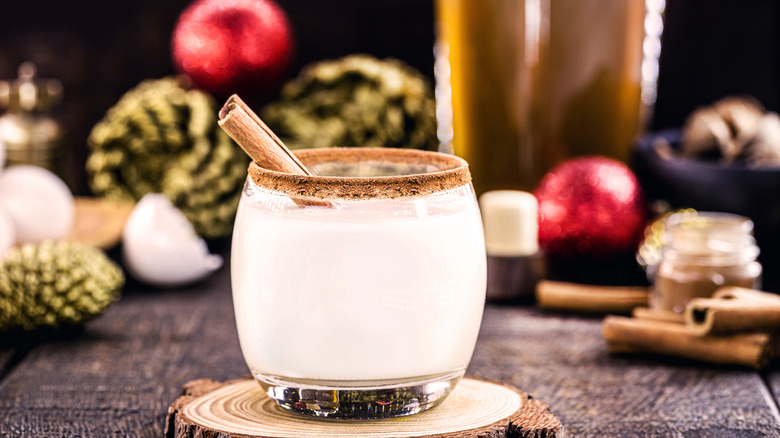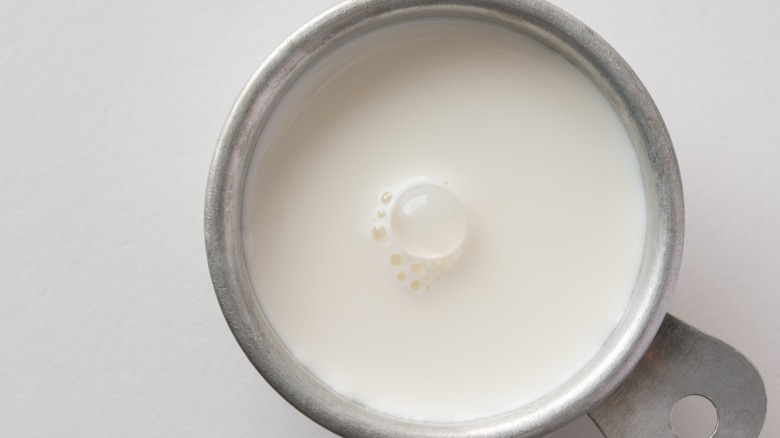14 Expert Tips For Making The Most Delicious Eggnog
Few other drinks create holiday cheer as well as eggnog. The egg-based drink might be the Christmas beverage du jour, but its association with the festive period came long after it was first created. Eggnog originally started as a drink called posset, a milk-based beverage popular in medieval Britain, which combined dairy and alcohol, and which is mentioned in several plays by William Shakespeare. When the drink started to be drunk more widely in the United States during the 18th century, rum began to make more frequent appearances in its recipe, and it quickly became the eggnog we recognize today and consume during the holiday period.
Today, eggnog is defined by its ultra-thick texture and boozy flavor, achieved by combining eggs, cream, milk, and liquor like brandy, cognac, or the aforementioned rum. It doesn't take an expert, though, to figure out that combining dairy and booze can be a recipe for disaster. So, we decided to help you avoid any mistakes and nail your 'nog this year by drawing on the expertise of industry professionals. We collected easy-to-execute tips and tricks from chefs, bar managers, and even academic sources that are designed to make your eggnog recipes simpler, tastier, and safer.
1. Don't overspend on booze
Everyone wants their eggnog to be the best it can be, so it's logical to try and find the most luxurious ingredients possible. Your alcoholic component, however, doesn't need to cost you too much, as The Columbia Room owner Derek Brown states via Liquor. "Eggnog is not ice cream," and the alcohol you use is unlikely to be noticed for its subtlety or intricacy of flavor, as it might be in the dairy dessert. Instead, you simply need a solid liquor that gives the drink some mellowness.
Brown himself uses a combination of cognac and dark rum and goes for a VS, which stands for very special cognac and doesn't break the bank. Having said this, you can use pretty much any dark liquor you have on hand, and each one will give your eggnog a different flavor. If you choose to use bourbon, for example, your eggnog will have slightly smokier, woodier notes. Using brandy gives the drink a gentle fruitiness. Although you can use clear liquors like white rum or vodka, it can be kind of a waste, as they'll provide alcoholic content with very little extra flavor.
2. For safe eggnog, hit the right temperature
Eggnog is delicious to some and terrifying to others — and that's largely because of its egg content. Some eggnog varieties have traditionally been made with raw eggs that aren't heated before being combined with the other ingredients and consumed. This, unfortunately, can be seriously risky due to raw eggs potentially containing salmonella, which may prompt foodborne sickness and create further health issues in certain individuals, according to Utah State University.
Therefore, you should always avoid using raw eggs wherever possible and instead, opt to heat your eggs sufficiently to eliminate the chance of food poisoning. You should always allow your egg mixture to reach 160 degrees Fahrenheit before taking it off the heat. Make sure you use an accurate food thermometer to measure this and heat your mixture slowly and gently to avoid any risk of the eggs cooking. You should also ensure that your eggs are pasteurized, even if you're heating them, to achieve total safety. This is especially important if you follow a recipe that asks you to fold your uncooked egg whites into the mixture to add extra thickness and body before serving.
3. Allow your flavorings to infuse
Eggnog can be a pretty simple mixture of dairy and booze, but it's the extra ingredients that make it pop. These ingredients, usually spices like nutmeg, cinnamon, and vanilla, give the drink extra layers of flavor, stopping it from being too cloying.
How you use these flavorings, though, will make a big impact on how good they taste. If you just decide to dash them in at the end, they won't distribute properly and will instead provide a taste that is too harsh, raw, and inconsistent. To get around this, do what Gordon Ramsay does and allow your spices to infuse in your milk, making it the first job that you do. Ramsay mixes his ground spices into whole milk using cinnamon, cloves, nutmeg, and ginger, as well as a few dashes of vanilla extract. After heating the mixture just to the boil, he then allows it to cool and infuse for ten minutes.
This infusion process essentially serves to activate, extract, and distribute the flavors of the spices. It also develops their flavors, unlocking their full potential for the drink. By resisting the urge to boil them for longer, you also don't kill off any of the taste of the spices.
4. Chill before adding your cream
When eggnog is made traditionally, it can end up true to its name: Between the raw egg yolks and the whipped egg whites, it can end up being seriously eggy. You can avoid this by making chef Heidi Fink's twist on eggnog, which avoids using raw eggs entirely and uses cooked egg yolks and cream to achieve thickness. Fink first heats the yolks with sugar and milk until thick, then takes it off the heat and whips some heavy cream until it gets stiff. She then mixes the two, serving it all over ice.
The key to this recipe's success, though, is to chill the egg yolk, sugar, and milk mixture before you add your cream in. If you add the cream while the mixture is still warm, it will thin out and lose its structure and will do nothing on the thickening front. If you're going to add booze to your eggnog, it's probably a good idea to put it into the egg mixture before you mix your cream in. That way, you don't end up thinning the eggnog once it's already thickened up.
5. Take your time
If there's one thing eggnog needs, it's patience. Depending on the recipe you're using, you may need to engage in a gentle cooking process to bring your eggs up to 160 degrees Fahrenheit. This should never be done at speed, states the Citizen Public House bar manager Richie Moe. "It's very intense and time-consuming. It's a commitment," Moe says via Phoenix New Times, who also states that he can cook his mixture for up to an hour before taking it off the heat.
Why so slow? A couple of reasons. Firstly, the slowness allows more of the moisture in the egg yolks to evaporate as it cooks, meaning that you end up with a thicker, more luxurious result. Going slowly also gives you a much greater sense of control as you heat it up, which means that the eggs are less likely to tip over the 160-degree mark. This is useful because when they do, they can start to essentially scramble, forming solid curds that turn it from a liquid into a solid. By taking your time, you keep things smooth and creamy and remove the chance of residual heat cooking them once they're removed from the stove.
6. For easy eggnog, use custard
There's no denying that making eggnog from scratch is a lot of effort, and some people are less confident about using and cooking raw eggs. So, to keep things way simpler, use custard as your base. Custard provides a smooth, creamy, flavorful foundation for your eggnog that you just have to add booze to at the end, avoiding any need for folding in heavy cream or egg whites.
Making homemade custard is also simpler than making regular eggnog, as you don't have to cook the egg yolks first. Instead, you heat your cream and milk to almost boiling, combine them with the yolks, flavorings, and cornflour, and then heat the whole thing together. You then have to chill the mixture until you're ready to add alcohol. Additionally, if you're not up to the task of making homemade custard, you can buy some in the store and add your chosen liquor to it to make an ultra-easy 'nog. Just remember, though, that some store-bought custards can be overly sweet or may be too thick for drinking. You may wish to dilute it with some whole milk if you opt to do this.
7. Grate your spices for extra intensity
Most eggnog recipes include spices, but it's easy to treat these as an afterthought and simply reach for the old jars in your pantry. When making the beverage, though, your spices shouldn't play second fiddle. "If you want really excellent Eggnog, you have to consider all the products you put into it, not just the booze," explains The Columbia Room owner Derek Brown, per Liquor. Pre-ground spices may provide a good amount of flavor if brand-new, but the longer they're exposed to oxygen, the duller they'll taste. Ground spices can start to lose their potency in as little as three months, and if you're only reaching for the ones you use in eggnog once a year, you could find that they're dull and lifeless the next time you pull them out.
That's why you should always grate or freshly grind your spices to extract maximum flavor and aroma. Spices like nutmeg and cloves provide their aroma and taste notes through the release of essential oils, and when you prepare them fresh, they'll have the most concentrated amount possible. If you're grating your spices, use the finest grate possible, like the one on a Microplane. The last thing you want is big flakes of spices in your drink, making it gritty.
8. Make it partly in advance, complete at the end
Eggnog takes a significant chunk of time and attention, and if you're making it for a party, you may need to devote those to other things — like your guests. The good news, though, is that you don't need to make it all in one go. After you've made your spiced custard mixture, you can keep it safely chilled in the fridge for up to three days in advance, according to America's Test Kitchen. Then, you simply need to finish it off with your beaten egg whites or whipped cream and your alcohol just before you're ready to serve it.
Making eggnog partly in advance is a godsend for busy cooks during the festive period, as it frees up your efforts to focus on your other food. Giving your custard a day or two to chill can also improve its flavor. When you allow it to rest, you allow the flavors in the mixture to settle and meld together, meaning you end up with a better-tasting drink. When chilling your partly-made eggnog, make sure you keep it covered and place it on a refrigerator shelf that is less frequently used to limit the risk of accidental spillage.
9. Use the best vanilla you can find
Vanilla is a key component of eggnog, with the spice providing balance to the dairy-heavy flavors. Because it's one of the most important flavors in the drink, you'll want to ensure that you have the best type of vanilla possible. Vanilla comes in many different forms, all of which vary in intensity and composition. While most people are familiar with using vanilla extract, the majority of these are artificial, and when used in a dish where it's not cooked, this can sometimes leave a bitter aftertaste.
This is why it's generally recommended that you either use a pure vanilla extract, vanilla bean paste, or vanilla pods. Pure vanilla extract generally has a similar intensity to artificial vanilla but doesn't provide that acrid flavor note. Vanilla bean paste, on the other hand, is super-concentrated and delivers a punchy vanilla flavor. Using the pods will also imbue your eggnog with a rich vanilla taste, but they can be a little more fiddly to work with, as you either need to scrape them out or soak them in your mixture and fish them out afterward.
10. Add your sugar slowly
Without sugar, eggnog becomes a drink that is dense, cloying, and overly boozy, so adding enough is essential. The speed that you add to your egg yolks at the start of your recipe, though, is almost as important as the amount you need. "The key to integration? Go slowly," says Alton Brown on YouTube.
Because your egg yolk base doesn't contain any other ingredients at this stage in the process, it's fairly low on moisture, and this means that the sugar will need a little more time to dissolve and incorporate. If you dump it all in at once, you end up with a mixture that's gritty and clumpy, which may potentially have an uneven flavor throughout.
The same rule applies to the sugar you add to your egg whites. Always pour it into the bowl slowly and gently, avoiding doing so in the middle of the bowl to not flatten it. Adding sugar to the whites helps, of course, to provide further sweetness to the beverage, but it also helps to stabilize the proteins in the mixture, giving you a firmer overall result.
11. Go heavy on the yolks
It's hardly a surprise that eggnog has a lot of eggs in it. However, while some recipes simply use a specific amount of separated eggs, those in the know like to mix up their ratios of egg yolks to egg whites. "You usually start with an even amount of egg whites and egg yolks. I'll add a few more yolks, because that's where most of the flavor comes from," says the Citizen Public House bar manager Richie Moe to the Phoenix New Times. "I usually go two parts egg yolk to one part egg white, measured in actual number of eggs."
Egg yolks contain the vast majority of an egg's fat content, thus the majority of its flavor. Using more yolks, therefore, gives you an eggnog that's rich and luxurious and will also give your drink that luscious, orange-yellow color. You should keep in mind, however, that with a higher amount of egg yolks, you may not need as much of your other high-fat ingredients, like whole milk or cream. People who aren't huge fans of eggy tastes may not wish to use too many yolks, too, as they bring a certain density of flavor to the drink.
12. Ensure that you temper your eggs
"A lot of the historical recipes [for eggnog] are uncooked, and that's because they'd be spiked with so much booze that the booze would kill anything," says America's Test Kitchen's Bridget Lancaster. Nowadays, though, eggnog tends to be slightly less boozy, allowing the other flavors in the drink to shine — and that means you have to cook your eggs. However, while some recipes call for heating your milk and then adding your eggs, the temperature shock that occurs when this happens can lead to a lumpy mixture.
The solution, as Lancaster shows, is to temper your eggs. Once her milk is boiled, she slowly pours it into her beaten egg mixture, whisking constantly to distribute the heat. This tempering process has two functions, the first being to help stabilize the eggs and the second being to essentially begin the cooking process. Once her eggs have tempered successfully, Lancaster then transfers her 'nog mixture to a pot and continues to heat it until it's thick and creamy. This process also helps to reduce the sometimes unpleasant raw egg taste that can put people off eggnog and instead create a drink that's delicately flavored.
13. Bottle it well before the big day
Because eggnog contains a hefty amount of eggs and dairy products, there's a tendency to assume that it goes bad pretty much immediately after you make it. The truth, however, is that you can make eggnog well in advance and leave it chilling in your fridge until you're ready to serve it. This is something that The Columbia Room owner Derek Brown has experience with, recommending that you bottle your 'nog and leave it developing ahead of time. "Along the way, there are complex chemical reactions happening that affect the flavor," Brown states to Liquor, with the spices, alcohol, and dairy mingling in the mixture to create something special.
By doing this, you're essentially creating aged eggnog, with the aging process producing a noticeably smoother flavor. Is it safe we hear you cry? Of course, it is — provided that you've added enough booze, of course, claims Rockefeller University professor and lab head Vincent Fischetti on ABC News. The alcohol content of aged eggnog keeps any bacteria at bay and may actually be safer than drinking fresh eggnog because the longer the alcohol has to kill off microbes, the more sanitary your drink will be. You can even make aged eggnog up to a year in advance, but if you're not confident, it's probably best to leave that to the pros and shoot for a shorter aging window.
14. Don't skimp on the fat
There's no getting around the fact that eggnog is a high-fat drink, but some people still try churning out eggnog recipes that use skimmed milk, which reduces the cream content. While these recipes do technically work, we really wouldn't recommend using them. Eggnog's flavor and thickness come largely from dairy fats. If you decide to swap them out for lower-fat versions, you won't just have a bland drink on your hands; you'll also have a thin, watery one.
So, embrace the fats, as Gordon Ramsay does. His eggnog recipe uses a hefty amount of whole milk and heavy cream, as well as a higher proportion of egg yolks. As well as flavor, dairy fats also improve the drink's mouthfeel, providing a velvetiness that can't be replaced. Remember that the alcohol you use will cut through some of the fat and density and lighten up the whole drink. While using high-fat dairy products will naturally make the drink more calorific, it's important to balance that out with the overall taste and quality of your eggnog and the fact that this is a festive beverage that should be enjoyed.
